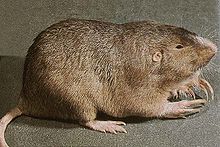
Franklin's ground squirrel is a species of squirrel native to North America, and the only member of the genus Poliocitellus. Due to the destruction of prairie, the populations of Franklin's ground squirrel have dwindled, approaching levels of concern. Its decline in the eastern portion of its range is mostly attributed to habitat fragmentation.
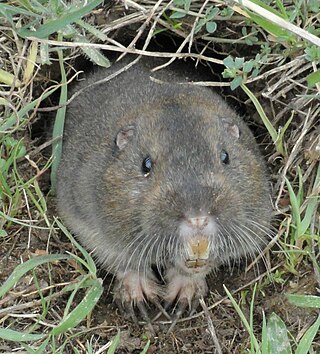
Pocket gophers, commonly referred to simply as gophers, are burrowing rodents of the family Geomyidae. The roughly 41 species are all endemic to North and Central America. They are commonly known for their extensive tunneling activities and their ability to destroy farms and gardens.

The smooth-toothed pocket gophers, genus Thomomys, are so called because they are among the only pocket gophers without grooves on their incisors. They are also called the western pocket gophers because they are distributed in western North America. They are considered distinct enough from other pocket gophers to be recognized as a separate subfamily or tribe.

Botta's pocket gopher is a pocket gopher native to western North America. It is also known in some areas as valley pocket gopher, particularly in California. Both the specific and common names of this species honor Paul-Émile Botta, a naturalist and archaeologist who collected mammals in California in 1827 and 1828.
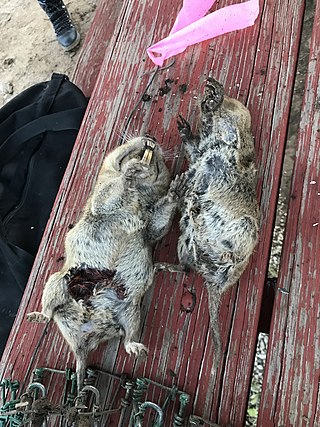
The yellow-faced pocket gopher is a species of pocket gopher that is native to shortgrass prairies in the south-western United States and northern Mexico. It is the species that lives north of the Southern Coahuila Filter-Barrier (SCFB). Among the different species, the yellow-faced pocket gopher has a small to medium-sized skull. The fossil of this genus was recorded from the pre-Pleistocene Benson Beds of Arizona.
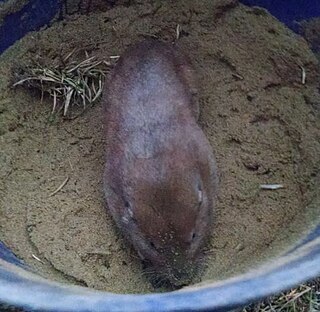
The southeastern pocket gopher is a species of pocket gopher that is native to the southeastern United States. It occurs in Alabama, Georgia, and Florida, where it is the only pocket gopher.

The genus Geomys contains 12 species of pocket gophers often collectively referred to as the eastern pocket gophers. Like all pocket gophers, members of this genus are fossorial herbivores.

The desert pocket gopher is a species of rodent in the family Geomyidae. It is found in the state of Chihuahua in Mexico and in Texas and New Mexico in the United States.
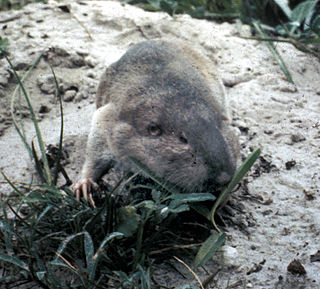
The Texas pocket gopher is a species of rodent in the family Geomyidae. It is found in Tamaulipas in Mexico and in Texas in the United States.
The central Texas pocket gopher or Llano pocket gopher is a species of rodent in the family Geomyidae. It is endemic to central Texas in the United States.
Buller's pocket gopher is a species of gopher that is endemic to Mexico.

The camas pocket gopher, also known as the camas rat or Willamette Valley gopher, is a rodent, the largest member in the genus Thomomys, of the family Geomyidae. First described in 1829, it is endemic to the Willamette Valley of northwestern Oregon in the United States. The herbivorous gopher forages for vegetable and plant matter, which it collects in large, fur-lined, external cheek pouches. Surplus food is hoarded in an extensive system of tunnels. The dull-brown-to-lead-gray coat changes color and texture over the year. The mammal's characteristically large, protuberant incisors are well adapted for use in tunnel construction, particularly in the hard clay soils of the Willamette Valley. The gophers make chattering sounds with their teeth; males and females make purring sounds when they are together, and the young make twittering sounds. Born toothless, blind and hairless, the young grow rapidly before being weaned at about six weeks of age.

The Wyoming pocket gopher is a species of gopher that is endemic to the United States. Between 1915 and 1979, it was generally considered to be a subspecies of the northern pocket gopher.

The Idaho pocket gopher is a species of rodent in the family Geomyidae. It is rather small, with a lightly built skull. Its fur color varies through the body and between individuals. Found in the western United States, it inhabits savannas, shrubland, and grasslands. Individuals live alone in burrows, staying active year-round. Many aspects of its behavior and biology are not well understood. The species is classified as being of least-concern by the International Union for the Conservation of Nature.

The mountain pocket gopher is a species of rodent in the family Geomyidae. It is endemic to California and Nevada. The Sierra Nevada are part of its range.

Townsend's pocket gopher is a species of pocket gopher endemic to the northwestern United States.
The Michoacan pocket gopher is a species of rodent in the family Geomyidae. It is monotypic within the genus Zygogeomys. It is endemic to Mexico where its natural habitat is temperate, high-altitude forests. Its numbers are declining and it is listed by the IUCN as "endangered".

Baird's pocket gopher or the Louisiana pocket gopher is a species of pocket gopher that is native to the southern United States. In total, there are three almost identical species of eastern pocket gopher; Geomys attwateri, G. bursarius, and G. breviceps. G. breviceps is larger in size, G. attwateri is medium-sized and G. bursarius is a bit smaller. Other than by size variation they are not identifiable by external features. Baird's pocket gophers are small rodents with most of their weight on the top half of their bodies.
Knox Jones's pocket gopher is a species of pocket gopher found in Texas and New Mexico. This species is named for Dr. J. Knox Jones Jr. (1929–1992), a prolific mammalogist at Texas Tech University.
Geomys jugossicularis, also known as Hall's pocket gopher and Colorado pocket gopher, is a species of pocket gopher native to the western United States. Little is known of its behavior or ecology aside from typical behaviors of the other pocket gophers.
